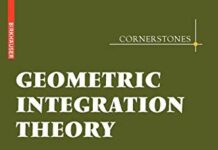
Ebook Info
- Published: 2013
- Number of pages: 305 pages
- Format: PDF
- File Size: 2.06 MB
- Authors: Steven G. Krantz
Description
This text provides a masterful and systematic treatment of all the basic analytic and geometric aspects of Bergman’s classic theory of the kernel and its invariance properties. These include calculation, invariance properties, boundary asymptotics, and asymptotic expansion of the Bergman kernel and metric. Moreover, it presents a unique compendium of results with applications to function theory, geometry, partial differential equations, and interpretations in the language of functional analysis, with emphasis on the several complex variables context. Several of these topics appear here for the first time in book form. Each chapter includes illustrative examples and a collection of exercises which will be of interest to both graduate students and experienced mathematicians.Graduate students who have taken courses in complex variablesand have a basic background in real and functional analysis will find this textbook appealing. Applicable courses for either main or supplementary usage include those in complex variables, several complex variables, complex differential geometry, and partial differential equations. Researchers in complex analysis, harmonic analysis, PDEs, and complex differential geometry will also benefit from the thorough treatment of the many exciting aspects of Bergman’s theory.
User’s Reviews
Editorial Reviews: Review From the book reviews:“This book is a compendium on the current state of Bergman theory in several complex variables would be an excellent source for a graduate course on Bergman theory in several complex variables. It is a must have for graduate students in this area as well as mathematicians wanting to learn more about this theory. It begins with the basics and ends at the forefront of current research.” (Steven Deckelman, MAA Reviews, December, 2014)“The monograph under review gives the reader a look at the ever-evolving Bergman theory. … The book covers a great deal of interesting topics on the Bergman kernel and metric. In particular, it abounds with useful and instructive calculation, much of which cannot be found elsewhere. It will certainly be an invaluable resource for students as well as seasoned researchers in geometric analysis of the Bergman kernel and metric.” (Jianbing Su, Mathematical Reviews, October, 2014) From the Back Cover This text provides a masterful and systematic treatment of all the basic analytic and geometric aspects of Bergman’s classic theory of the kernel and its invariance properties. These include calculation, invariance properties, boundary asymptotics, and asymptotic expansion of the Bergman kernel and metric. Moreover, it presents a unique compendium of results with applications to function theory, geometry, partial differential equations, and interpretations in the language of functional analysis, with emphasis on the several complex variables context. Several of these topics appear here for the first time in book form. Each chapter includes illustrative examples and a collection of exercises which will be of interest to both graduate students and experienced mathematicians.Graduate students who have taken courses in complex variablesand have a basic background in real and functional analysis will find this textbook appealing. Applicable courses for either main or supplementary usage include those in complex variables, several complex variables, complex differential geometry, and partial differential equations. Researchers in complex analysis, harmonic analysis, PDEs, and complex differential geometry will also benefit from the thorough treatment of the many exciting aspects of Bergman’s theory. About the Author Steven G. Krantz is one of Springer’s and Birkhäuser’s most prolific and popular authors in the field of functional analysis, geometric analysis, and partial differential equations. Krantz is the series editor of Birkhäuser’s ‘ Cornerstones’ graduate text series and the founder and editor-in-chief of “The Journal of Geometric Analysis”, considered a society journal previously published by the AMS and often acts as an advisor to several senior editors at Springer/ Birkhäuser . He is also editor-in-chief of the “Journal of Mathematical Analysis and Applications”. Professor Krantz is currently the editor-in-chief of the AMS Notices and also edits for “The American Mathematical Monthly”, “Complex Analysis and Elliptical Equations”, and “The Bulletin of the American Mathematical Monthly”. Krantz is also known for his wide breadth of expertise in several areas of mathematics such as harmonica analysis, differential geometry, and Lie groups, to name a few. Notable awards include Chauvenet Prize (1992), Beckenbach Book Award (1994), Kemper Prize (1994), Outstanding Academic Book Award (1998), Washington University Faculty Mentor Award (2007). Read more
Reviews from Amazon users which were colected at the time this book was published on the website:
⭐ベルグマン核やベルグマン計量が複素解析や複素幾何の研究に重要な役割を果たすことは、この分野の専門家や愛好家の方々に良く知られている。本書はこの分野への本格的な解説書であり、とても有用な一冊と言える。複素数空間Cnの有界領域Ω上の正則関数や正則写像を考察する際に基礎をなす構成要素として、Ω上の正則関数たちがなすL2空間(A2(Ω)と表記されるヒルベルト空間)の再生核としてのベルグマン核、正則成分への射影であるベルグマン射影P、正則関数や正則写像の境界∂Ωへの正則(滑らかな)拡張の存在を保証する定理、などが挙げられる。有界領域Ωのベルグマン核の対数をポテンシャルとするベルグマン計量(ケーラーでもある)に関し、二つの領域間の双正則写像が等長写像になることから、有界領域の自己同型群の研究や双正則写像の領域の境界への拡張の研究に、ベルグマン核の境界・漸近挙動が重要な役割を演じること、また∂-ノイマン問題の可解性やその解の挙動と密接に関連しそうなこと、などは容易に推察できる。本書を通読して特に印象に残ったことを以下に述べてみたい。先ず、S.R.ベルによって導入された「条件R」(領域Ωの閉包Ω-上のC∞関数がベルグマン射影PでΩ-上のC∞関数に写されるという条件)に関わる話題の解説が非常に詳しいことを挙げたい。「滑らかな境界を持つ有界強擬凸領域は条件Rを満たす」というコーンの有名な結果、及びそれを援用する「このような領域間に双正則写像が存在すれば、それらの境界まで滑らかな微分同相写像に拡張できる」というフェファーマンの定理の別証明とベルによるこの定理の拡張(定理4.4.2)が詳しく叙述されており、更に「有限型(finite type)の領域が条件Rを満たす」というキャトリンの結果が紹介されており非常に興味深い。次に、ディードリッヒ-フォルナエスの「ワーム」と呼ばれる領域の解説が詳しいことを挙げたい。ワームが「スタイン近傍基」(Stein neighborhood basis)を持たない滑らかな境界を持つ有界擬凸領域の最初の例である、という歴史的事実を本書で初めて教えられた。また、「ワームでは条件Rが成立しない」というクリストの有名な結果に対し、上記のコーンの結果に照らしてワームのどこで強擬凸性が崩れているのか、更に条件Rが満たされないのはどの様な(十分)条件が成り立つ場合なのか、などが詳しく考察されておりとても面白く有益である。最後に、ベルグマン計量を持つ空間に対し「Bergman Representative Coordinates」という一種の標準座標系が存在することが示され、それが多くの応用を持つこと、例えば「複素数空間Cnの有界領域Ωのベルグマン計量が定正則断面曲率を持てば、Ωは単位球体と双正則同値である」という「ルー(Lu)の定理」や有界強擬凸領域の正則自己同型群の半連続性を主張する「グリーン-クランツの定理」の証明に活用されていることが分かり非常に面白く興味深い。上記の他にも、ベルグマン核の零点に関する「ルー予想」の反例やその境界点に収束する正則同型写像列の存在が必然的に単位球体を意味するという「ウォン-ローゼイの定理」などにも触れられており、経験者の方にも役立つ情報が多く見出されるのではないかと思う。最後に個人的な感想を二つほど述べたい。私がこの分野に興味を持ったのは、大沢健夫先生の著書『多変数複素解析』、『岡潔 多変数関数論の建設』、『現代複素解析への道標 レジェンドたちの射程
⭐』などを学習したことによる。特に、最後の著書でベルントソンとレンペルトによるL2拡張定理の素晴らしい別証明の存在に触れられており、ベルグマン核の幾何解析の基礎をもっと詳しく勉強してみたいという気持ちを抑えることが出来なかった。これが本書の存在を知り、読んでみた最大の理由である。本書を読み終えて強く感じるのは、数学という学問は先駆者の業績に感化された継承者に引き継がれて更に発展するということである。今回ヘルマンダ―の論説「A History of Existence Theorems for the Cauchy-Riemann Complex in L2 Spaces」(2003)を読み直して、この分野におけるD.C.スペンサーの影響の大きさを再認識させられた。この論説において、∂-ノイマン問題に関するスペンサーの研究がその後のコーンやヘルマンダ―の研究に及ぼした影響の大きさが指摘されている。スペンサーから学位指導を受けた弟子としてコーンやグリフィスが、更にコーンの弟子としてキャトリンやフォーランドが挙げられることを知れば、「1950年代にプリンストンで複素多様体論が急速に発展した原動力はスペンサーの熱意であった」という小平先生の見解に多くの方が賛同されるのではなかろうか。調和解析の大家E.M.スタインからもフェファーマンやテレンス・タオなどの高弟が出ている。本書の著者S.G.クランツの学位指導者がE.M.スタインとコーンであることを知り、とても嬉しい気分に浸ることができた。
⭐
Keywords
Free Download Geometric Analysis of the Bergman Kernel and Metric (Graduate Texts in Mathematics, 268) in PDF format
Geometric Analysis of the Bergman Kernel and Metric (Graduate Texts in Mathematics, 268) PDF Free Download
Download Geometric Analysis of the Bergman Kernel and Metric (Graduate Texts in Mathematics, 268) 2013 PDF Free
Geometric Analysis of the Bergman Kernel and Metric (Graduate Texts in Mathematics, 268) 2013 PDF Free Download
Download Geometric Analysis of the Bergman Kernel and Metric (Graduate Texts in Mathematics, 268) PDF
Free Download Ebook Geometric Analysis of the Bergman Kernel and Metric (Graduate Texts in Mathematics, 268)




